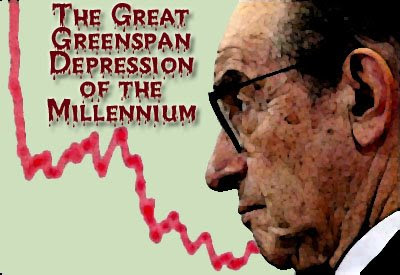 Alan Greenspan’s spirited defense of late about his legacy has more in common with revisionist history and self-serving grandstanding than the actual truth: He is largely blamed for creating the chaos that we now know as the “dot com bubble”, the following 2001 deep recession that destroyed trillions of dollars in economic value as well as millions of jobs, and the current economic catastrophe whose effects we have not yet been able to quantify but which already has left millions of hard working families literally on the streets, not only from losing their homes but also from losing their jobs as companies close down due to the credit crunch.
Alan Greenspan’s spirited defense of late about his legacy has more in common with revisionist history and self-serving grandstanding than the actual truth: He is largely blamed for creating the chaos that we now know as the “dot com bubble”, the following 2001 deep recession that destroyed trillions of dollars in economic value as well as millions of jobs, and the current economic catastrophe whose effects we have not yet been able to quantify but which already has left millions of hard working families literally on the streets, not only from losing their homes but also from losing their jobs as companies close down due to the credit crunch.
Mr. Greenspan caused the 2001 recession by consistently underestimating the ability of technological change and increased productivity to dampen inflationary pressures. Refusing to accept that the American economy was capable of growing at 3.5% to 4% annual rate without generating inflation, his Fed started hiking interest rates in 1999 and went on too fast and too far. The infamous 50 basis-point hike in May 2000 triggered the stock market’s collapse, evaporated millions of jobs, obliterated the life savings of over thirty million Americans and created the ensuing recession.
Mr. Greenspan then gave birth to the housing bubble in the wake of 9/11 by consistently overestimating the threat of deflation. The result was historically low interest rates that provided crucial air for the resultant housing bubble. The low rates that normally would fuel investment and growth were exploited by irresponsible banks and mortgage companies and their brokers greedily looking to increase their returns. The over-leveraging and securitization of these loans coupled with the lack of oversight by the federal government led to the credit mess whose final consequences are yet unknown. (see A Primer on Sub-Prime Mortgages ).
We must not forget, however, the fact that even the ugliest sub-prime loans were getting paid as scheduled. It was not until the rates jumped so violently that they became delinquent in droves. No matter how solid a country’s economy is, the instability created by a bad policy decision is enough to turn a boom into a bust. Stability is the catalyst that fosters investment, growth and long term prosperity.
 Today, without official duties and no longer involved with the Fed, Mr. Greenspan continues to create havoc, unnecessary panic and above all, destruction of value. His public musings about the stock market and the economy only add volatility to the current crisis while undermining the already tenuous position of current Fed Chairman, Ben Bernanke, Greenspan’s own boy. For the public good, it would be best if he let his defense rest and simply zipped his lips and go home with his millions in earnings. But Greenspan has shrewdly figured that keeping himself on the limelight does help him sell more books and book more lectures and consulting gigs which have made him a very wealthy man.
Today, without official duties and no longer involved with the Fed, Mr. Greenspan continues to create havoc, unnecessary panic and above all, destruction of value. His public musings about the stock market and the economy only add volatility to the current crisis while undermining the already tenuous position of current Fed Chairman, Ben Bernanke, Greenspan’s own boy. For the public good, it would be best if he let his defense rest and simply zipped his lips and go home with his millions in earnings. But Greenspan has shrewdly figured that keeping himself on the limelight does help him sell more books and book more lectures and consulting gigs which have made him a very wealthy man.
 The chart at the right graphically illustrates the stock market carnage. This chart presents the Dow divided by the price of one ounce of gold. This results in what is referred to as the Dow / gold ratio or the cost of the Dow in ounces of gold. When priced in that universal world currency (gold), the Dow is in the midst of a massive eight year bear market!
The chart at the right graphically illustrates the stock market carnage. This chart presents the Dow divided by the price of one ounce of gold. This results in what is referred to as the Dow / gold ratio or the cost of the Dow in ounces of gold. When priced in that universal world currency (gold), the Dow is in the midst of a massive eight year bear market!
In its own words, the official top objectives of the Federal Reserve are:
1) Conducting the nation’s monetary policy by influencing the monetary and credit conditions in the economy in pursuit of maximum employment, stable prices, and moderate long-term interest rates.
2) Supervising and regulating banking institutions to ensure the safety and soundness of the nation’s banking and financial system and to protect the credit rights of consumers.
3) Maintaining the stability of the financial system and containing systemic risk that may arise in financial markets.
In simpler terms, what this means is that the Federal Reserve's main goals are to foster economic stability and prosperity. In this regard, Greenspan’s record is dismal. Since 1999, the destruction of value that Greenspan has caused is estimated at over 7 Trillion Dollars. That is a very large number. To put this figure in perspective: the entire U.S. economy generated only about $13.8 trillion in 2007, and total household wealth is currently only about $45 trillion.
In the history of the United States no enemy has ever been able to inflict upon us more harm. In this regard, Greenspan’s legacy of financial destruction will be remembered as “The Great Greenspan Depression of the Millennium”.







 Entrepreneur, former Fortune 500 senior executive, semi-retired at the age of 39 after founding and growing several businesses in High Technology, Management Consulting and Manufacturing.
Entrepreneur, former Fortune 500 senior executive, semi-retired at the age of 39 after founding and growing several businesses in High Technology, Management Consulting and Manufacturing.
This man, so revered by a mass of ignorants, has acted like a mad physician experimenting with mice. Trouble is... we are the mice.
ReplyDeleteHistory will remember Greenspan as the man who took the most prosperous nation in the world to its knees.
Utterly outrageous that one old demented man was given so much power.
ReplyDeleteGreenspan and Co. should have been prosecuted for Treason long ago. They have single-handedly literally destroyed the world's economy. Never in history have so few people done so much damage to so many.
ReplyDeleteGreenspan and the Federal Reserve [=Bankers' Cartel] caused the Depression that's coming - this [2007-09] so far, was nothing yet!
ReplyDelete